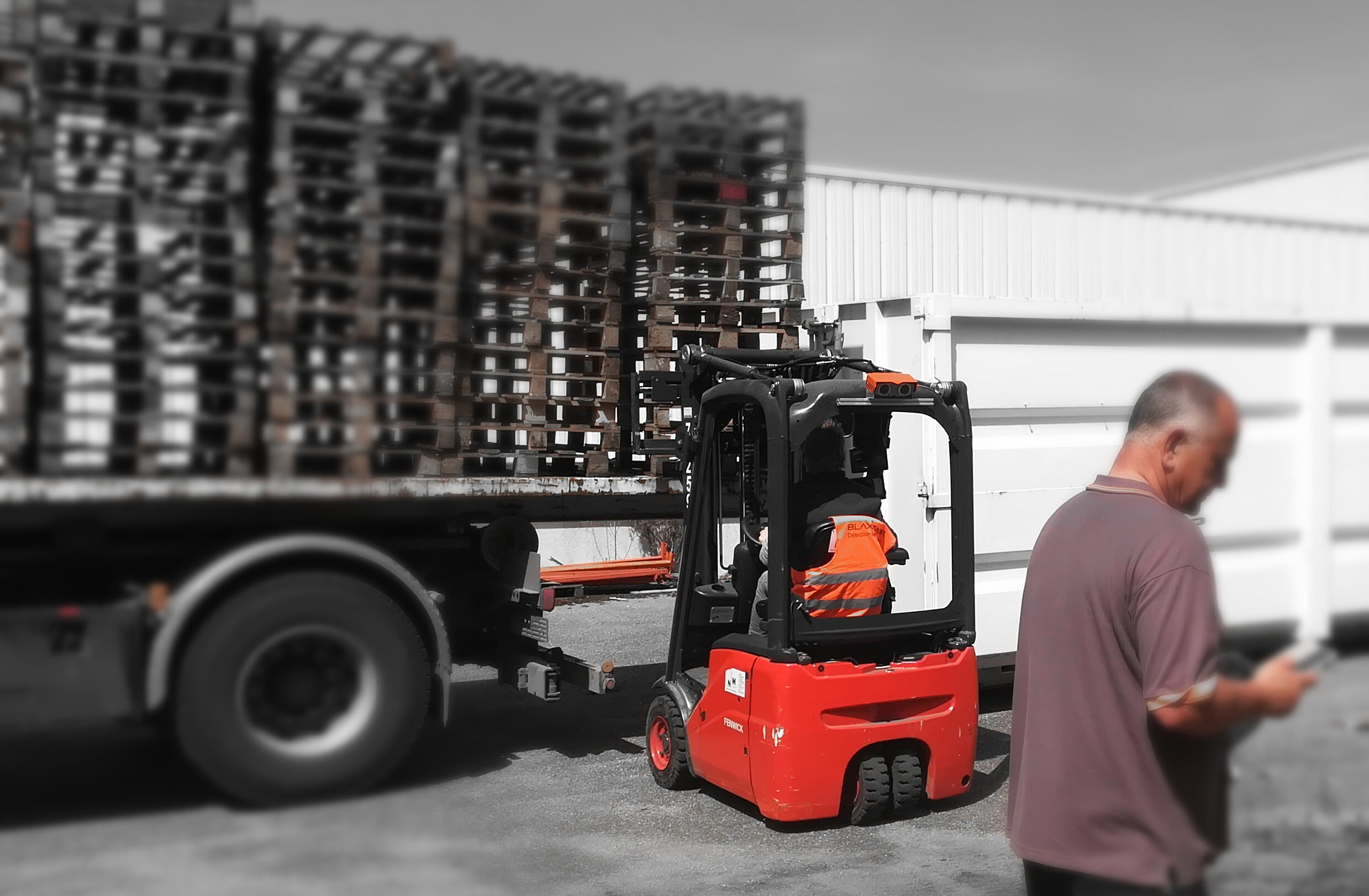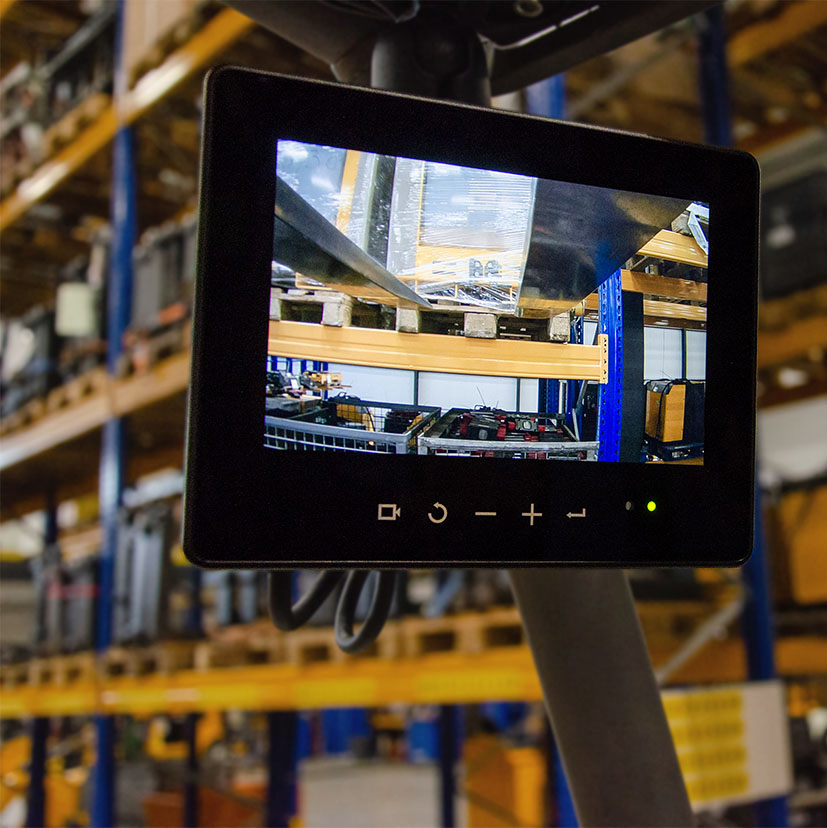
Did you know?
– 1 in 10 forklifts will be in an Accident this year!
– It is a matter of “WHEN” not “IF”
– If the fleet is 10 or more – an ACCIDENT will happen THIS YEAR!
See below how to Prevent Warehouse Traffic Accidents – SAVE LIVES & AVOID LOSS with our variety of effective TRAFFIC SAFETY HIGH-TECH PRODUCTS.

• What is a Fork Camera system: A device for the operator to see the forks when going into a pallet at height.
• How do Cameras Work: Wired or wireless camera mounted to the forks or fork carriage, linked to a HD monitor that is installed in the operator compartment.
• What types of equipment use these: Any forklift. Can be I.C. or Electric Power.
• Will the camera interfere with any warehouse tech or other machine functions: No, the camera system is a simple setup of a monitor, camera, HD cable and 12V inverter for specific electric forklifts.
• How is the camera powered: By batteries or by a connection to the unit’s battery.
• Who should install this: It is recommended that the authorized dealer for the systems provide installation options for you. Installation can normally be done onsite at a customer facility, or at the authorized dealership.
• IT Involvement: None.

• What is a Fork Camera system: A device for the operator to see the forks when going into a pallet at height.
• How do Cameras Work: Wired or wireless camera mounted to the forks or fork carriage, linked to a HD monitor that is installed in the operator compartment.
• Will the camera interfere with any warehouse tech or other machine functions: No, the camera system is a simple setup of a monitor, camera, HD cable and 12V inverter for specific electric forklifts.
• How is the camera powered: The camera system is powered either by batteries or by a direct wire to the machines battery supply.
• Who should install this: It is recommended that the authorized dealer for the systems provide installation options for you. Installation can normally be done onsite at a customer facility, or at the authorized dealership.
Since 1956 National has built a foundation of integrity with our customers like you!
Here are eight accident statistics that should cause you to exercise extreme caution when operating a forklift:
1. Forklifts account for around 85 deaths every year – a 28% Increase since 2011
2. Forklift accidents that result in serious injury total $34,900 annually.
3. Non-serious injuries related to forklift accidents reach $61,800 each year.
4. A forklift overturning is the most common incident, accounting for 24% of all forklift accidents.
5. If companies implemented more stringent training policies, the Occupational Safety & Health Administration (OSHA) estimates that about 70% of forklift accidents in the US could be prevented.
6. On average 100 people are seriously injured in a forklift accident every day and 1 person is killed in a forklift accident every 4 days in the United States alone.
7. 36% of forklift-related deaths are pedestrians
8. Approximately 11% of forklifts in the United States will be involved in an accident each year. Meaning if your facility has 10 or more – something is going to happen this year.
Approximately one in ten forklifts are involved in accidents every year and cause almost 100,000 injuries annually. Besides the number of hurt citizens, forklift accidents cause many other catastrophes with one being the devastating costs.
When safety training has the power to help companies save thousands of dollars each year and prevent accidents, it’s an investment that pays for itself multiple times over. However, many companies skip this essential training and put their entire workplace in danger, risking the following hidden costs.
Equipment Damage Repairs and Replacements
A few years ago, a maintenance worker in Massachusetts was tending to commercial flower beds, digging up the flower beds along the streets, when his forklift randomly collapsed and fell through the sidewalk to a delivery chute underneath. After the investigation, it was found that the worker did not know that the city’s sidewalks are built on top of loose, decades-old grating. The accident did not kill the worker but it most certainly caused substantial damages to the forklift and to the sidewalk area the employee was working on.
It’s estimated that a forklift out of commission for repairs costs thousands of dollars every day in lost profit. Forklift damage contributes greatly to the amount of unnecessary costs to a company. It’s estimated that forklift damage can add as much as 5% to the cost of a standard truck lease. When considering an entire fleet of powered trucks, the costs add up to thousands of dollars of unnecessary, unplanned costs each year.
Workers’ Compensation
It is the employer’s responsibility to cover any medical expenses for a worker injured in a work-related accident. The cost of forklift accidents involving injured workers can cost as high as $38,000 in direct costs per injured worker and $150,000 in indirect costs.
Loss of Production = Loss of Profits
According to the CDC, loss of productivity due to absent worker’s costs employers approximately $225.8 billion each year. This is about $1,685 per employee. Accidents involving forklifts may not only involve loss of productivity from an injured worker, but also medical expense coverage, equipment damage, and a forklift out of active duty. When calculating the cost of forklift accidents, employers also need to take into account the management time spent looking into the injured worker case, investigating the accident, and supervising the tasks needed to get the go-ahead to resume work.
Fines and Legal Costs
OSHA requires that employers provide a hazard-free work environment and safety training to employees. As a result, if they find out a workplace was operating under unsafe practices and with untrained workers following an accident, fines will be involved.For non-serious violations, fines start at $12,675 per violation.The penalty for willful or repeated violations is $126,749 per violation. The cost of forklift accidents extends well beyond the price of equipment repairs and structural damage; it may cost an employer their business.
Loss of Staff
A lack of safety in the workplace often leads to reduced morale and increased stress among employees. When keeping workers safe is a low priority, profits and worker pay is often negatively impacted. And when fear is brought into the picture following workplace accidents, a company may find itself lacking its best employees who left seeking greener pastures. The average cost of replacing personnel equals to about $30,000. For smaller organizations especially, the loss of key personnel may make it impossible to meet contract deadlines. The failure to complete projects can end a business, or tarnish a company’s reputation and lead to loss of new or repeat business.
The Serious Consequences of Forklift Accidents
Injured workers, forklift damages, and costly fines are serious consequences of forklift accidents. However, fatalities caused by forklift accidents are the very real and very serious consequences that can happen. It is estimated that about 100 forklift deaths happen every year on worksites, and the majority of them are preventable. Not only are employers left with the task of paying for any incurred medical expenses and compensation costs, but families are left without their loved ones. Proper training and certification is quite possibly the most important way for workers and employers to reduce the number of fatalities on worksites and to protect themselves from these severe consequences.
Why Are Forklifts So Dangerous?
There are a number of reasons why forklifts can be such a workplace hazard.
• They can weigh up to 9,000 pounds, which is three times heavier than many cars
• They can travel up to 18 mph
• Unlike a car, forklifts only have brakes in the front, making them harder to stop
• Forklifts are heavier in the rear to compensate for the heavy loads being carried in the front. This uneven weight distribution can make a forklift difficult to handle.
• A forklift is turned by the rear wheels, causing the rear end to swing outward. This increases the chance of tipping over during tight turns.
• Loads are carried in the front of a forklift, which can obstruct the view of the driver
• Forklifts are often used to raise hefty loads to considerable heights, a combination that is always dangerous